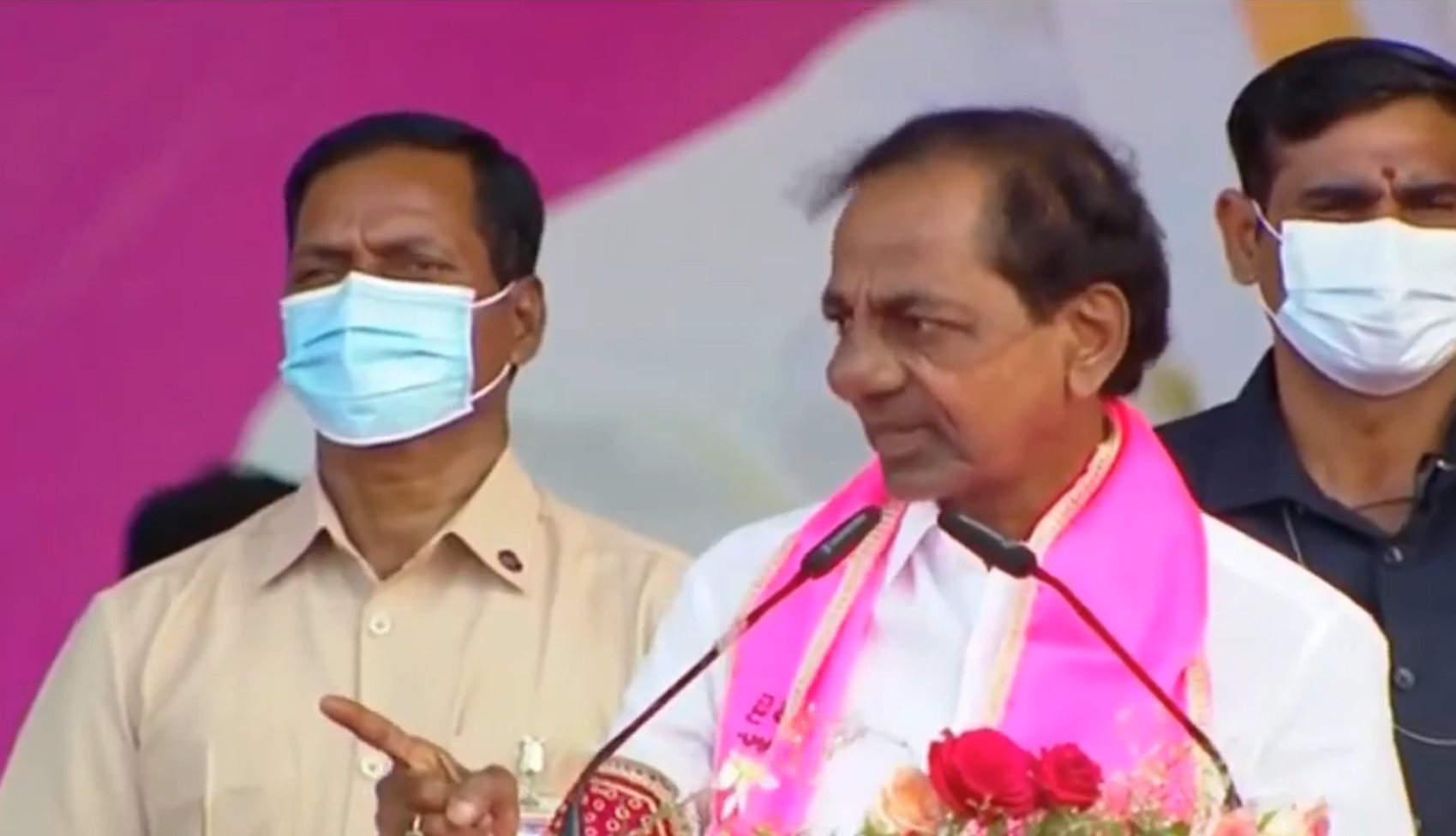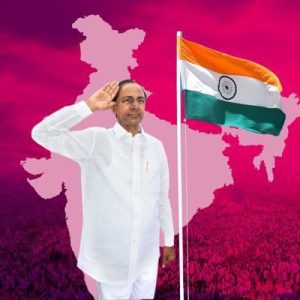The Telangana chief minister is right in assessing a clear political space in the anti-Modi sphere at the national level. How will his party differ from other outfits opposed to the BJP?

Telangana Chief Minister K Chandrashekar Rao addresses the people in a meeting in Munugode on 20 August. KCR is expected to launch a national party on Vijayadashami (Twitter/@trspartyonline)
Telangana Chief Minister and TRS supremo K Chandrashekar Rao is expected to launch his national political outfit on Vijayadashami, a day considered to be auspicious for commencing any activity.
The launch of the national party comes in the backdrop of KCR’s call for a BJP-mukt Bharat. Therefore, it is obvious that the Bharata Rashtra Samithi, a probable name for KCR’s national party, will join the potpourri of anti-BJP parties in the country.
It is still not clear how his party will be different from a wide array of political outfits that are opposed to the saffron brigade, except for the fact that KCR is emphasising an agenda that exposes the brazen failures of the BJP and perhaps even the Congress, which have been at the helm of affairs for most of the time in independent India.
During his speeches in public meetings and media briefings, KCR has been focusing on the reality and the possibility — the India that is and India that could have been in the last 75 years.
But his claim of radically different politics free from a mere political conglomeration becomes incomprehensible when seen against the background of KCR’s hectic parleys with a host of political leaders, many of whom have either joined hands with the BJP in the past or may perhaps not hesitate to do so if the future political arithmetic drives them towards such a choice.
KCR’s national political foray is predicated on the premise that there exists a political vacuum in the country. The Congress is crumbling and lacks a strategy to revive in the foreseeable future. The Left is losing its sheen. The AAP is still not a national force to reckon with. The appeal of regional parties is constrained by their political geography.
Given this milieu, KCR firmly believes that there is a clear political space in the country that needs to be urgently filled. This is precisely the perception the author could get when he had an over-an-hour-long personal interaction with KCR a couple of weeks ago.
The question of whether or not a political vacuum exists should be seen in two dimensions. At the national level, the Modi juggernaut seems to be invincible given the splintered opposition. The TINA (there is no alternative) factor is certainly helping the BJP. Several opinion polls have repeatedly suggested that no opposition leader could match Prime Minister Narendra Modi’s popularity. The latest India Today ‘Mood of the Nation’ survey also reveals that Modi still remains the most popular leader despite people’s disenchantment with his handling of the economy, especially jobs and inflation.
Therefore, KCR is right in assessing a clear political space in the anti-Modi political sphere at the national level.
However, the other way of looking at it is that India’s electoral battle is primarily fought in the states. India’s mandate is a sum total of mandates in the states. Modi may not have formidable opposition at the national level. But several regional satraps pose an unassailable challenge to the Modi-led BJP.
The second premise on which KCR is hoping to realise his national political ambitions is that the Telangana model can catch the imagination of Indian people.
More recently, KCR gave a slogan: “Cut Modi power to get free power”. His promise of nationwide free power for agriculture is an attempt to sell the Telangana model to the national electorate. KCR wants to bank upon farmers’ distrust of Modi to emerge as a challenger to saffron politics. He held discussions with farmer leaders from 26 states, who have unanimously urged KCR to take up their cause at the national level.
Besides, reports indicate that KCR is expected to take up issues of the Scheduled Castes and Scheduled Tribes and other sections of society whom he wants to rally against the BJP regime.
Modi stormed to power by promoting the Gujarat model. Arvind Kejriwal expanded into Punjab and aspires to reach out to voters across the country by mentioning the Delhi model during his campaigns. Why can’t KCR catch the national mood with the Telangana model? This is the mood of the TRS supporters who are craving for KCR’s national entry.
It is too early to predict whether the Telangana model convinces the voters across India. But a few things need a special mention here.
It is wrong to conclude that the Gujarat model alone propelled Modi to power. It is also true that BJP has not relied on the Gujarat model alone to come to power in 2014. Of course, the BJP has certainly used the Gujarat model to firmly establish Modi’s persona. But the BJP’s electoral muscle, organisational strength, and ideological spread — deftly cultivated over decades and ably supported by the Sangh Parivar — scripted the party’s victory in 2014. The Gujarat model is only part of such a larger picture.
There is also a difference between the AAP marketing the Delhi model as its unique selling proposition and KCR expecting to promote the Telangana model as a poll agenda for the whole of India. The AAP emerged out of an anti-corruption movement that finds resonance across Indian voters. The TRS is a product of the Telangana identity movement that has strong roots in legitimate regional aspirations limited to a particular geography, which was strongly contested even in the neighbouring Seemandhra region.
The Delhi model is also based on clean politics and good governance, which are common aspirations of voters belonging to any geography or demography. The Telangana model is primarily based upon welfarism and populism, which is already practised across India, including in the BJP-ruled states, in some measure or other.

The TRS sported a picture of the national flag as the display picture on social media before Independence Day, with party chief and Telangana CM KCR seen saluting it (Twitter/TRS)
Indian politics has always been dominated by the north Indian political idiom. Hindi-speaking leaders have always had a natural advantage. KCR has to overcome this North-South divide and invent something that goes beyond the limits of the Telangana model to lure voters across the diverse political landscape.
KCR has been getting a favourable response from a cross-section of opposition leaders, including those who are allied with the Congress, though the TRS supremo is clearly avoiding the grand old party due to Telangana-specific factors.
But the moment KCR launches a national political party, these same leaders may view him with suspicion as he will be vying for political space in their states too. This is evident from the mutual disdain between the AAP and the Congress, the Left and the Trinamool, etc. How will KCR reconcile his efforts towards creating a national party and an opposition conglomerate?
Thus, the picture is hazy as the idea of a KCR-led national party is still at a formative stage. The agenda, action plan, the leaders who may join, etc., are still unknown, making any prediction on the prospects of KCR’s national voyage subjective and therefore unwarranted.
(K Nageshwar is a political analyst and professor of journalism at Osmania University. He is a former member of the Legislative Council, both in united Andhra Pradesh and Telangana. He has worked as an editor in print and electronic media. These are the personal views of the author)

Apr 18, 2024

Apr 18, 2024

Apr 18, 2024

Apr 18, 2024

Apr 18, 2024